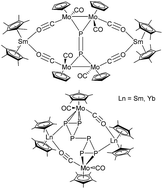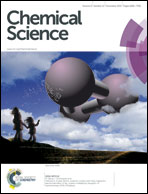The approach to 4d/4f-polyphosphides†
Abstract
The first 4d/4f polyphosphides were obtained by reaction of the divalent metallocenes [Cp*2Ln(thf)2] (Ln = Sm, Yb) with [{CpMo(CO)2}2(μ,η2:2-P2)] or [Cp*Mo(CO)2(η3-P3)]. Treatment of [Cp*2Ln(thf)2] (Ln = Sm, Yb) with [{CpMo(CO)2}2(μ,η2:2-P2)] gave the 16-membered bicyclic compounds [(Cp2*Ln)2P2(CpMo(CO)2)4] (Ln = Sm, Yb) as the major products. From the reaction involving samarocene, the cyclic P4 complex [(Cp*2Sm)2P4(CpMo(CO)2)2] and the cyclic P5 complex [(Cp*2Sm)3P5(CpMo(CO)2)3] were also obtained as minor products. In each reaction, the P2 unit is reduced and a rearrangement occurred. In dedicated cases, a P–P bond formation takes place, which results in a new aggregation of the central phosphorus scaffold. In the reactions of [Cp*2Ln(thf)2] (Ln = Sm, Yb) with [Cp*Mo(CO)2P3] a new P–P bond is formed by reductive dimerization and the 4d/4f hexaphosphides [(Cp*2Ln)2P6(Cp*Mo(CO)2)2] (Ln = Sm, Yb) were obtained.


 Please wait while we load your content...
Please wait while we load your content...